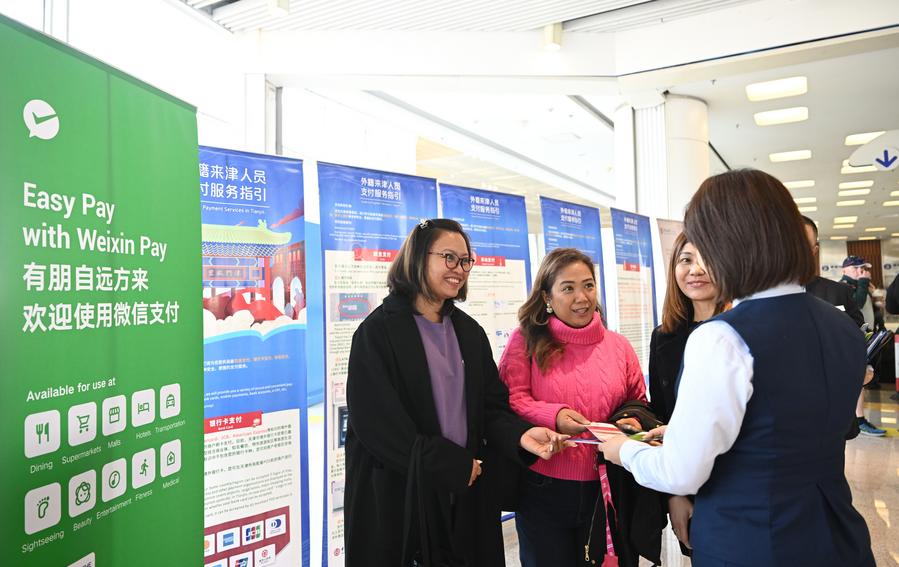Digital Payments Bring Better Travel Experience in China

China is taking a range of steps to make it easier for international visitors to make money transactions for purchases in China.
China’s visa-free policy keeps expanding and the country has entered a new era of welcoming visitors from an increasing global reach. By January 1, 2024, China had inked mutual visa exemption agreements with 157 countries, simplified visa procedures with 44 countries, and enjoyed comprehensive mutual visa exemptions with 23 countries, including Thailand, Singapore, the Maldives, and the United Arab Emirates.
A range of favorable visa policies and newly released measures of convenient entries into China have attracted more foreign tourists to the country. According to data from Ctrip.com, a leading travel services platform in China, during the Spring Festival in 2024, inbound tourism orders increased more than 10-fold from last year, with visitors mainly coming from Japan, the United States, the Repulic of Korea, Malaysia, Germany, and Thailand.
Though the number of tourists has been growing thanks to the country’s visa-free policy, it is worth noting that there are distinct differences in payment habits between Chinese shoppers and visitors from other countries.
Jin Li, vice president of Southern University of Science and Technology, pointed out that in China, QR codes are believed to be one of the lowest-cost mobile payment solutions. Favored by small and medium-sized business owners, mobile payment is widely available in most urban and rural areas across China. QR code-based payments now dominate mass consumption scenarios, especially those of small amounts. The penetration rate of card payments is relatively low among Chinese small and medium-sized businesses, considering that the cost of a point of sale (POS) machine or transfer commission fee is high. Foreign tourists, however, are more used to card, near-field communication (NFC), cash, and other payment options.
Some international visitors therefore may encounter difficulties in paying their way due to different payment methods.
Natalia Bayona, UN Tourism Executive Director, said that China’s visa-exemption policies are conducive to global tourism recovery. A thriving tourism industry in China is expected to boost tourism development in its neighboring countries, Bayona also noted.
But how does China go about enhancing its appeal to international tourists so as to maintain its position as the largest tourism consumption market and one of the most important tourist destinations?
Jin made several suggestions regarding this question and how to overcome the quandary of payment challenges that may arise.

Upgrading payment services
In 2023, China announced a payment plan for foreign visitors in the country, featuring a system of paying large bills by card, small bills by QR code, and using cash as a backup plan. It basically covers all kinds of transaction scenarios in the country. With the joint effort of the finance, commerce, and culture and tourism departments, as well as Alipay and other enterprises, this payment plan has been upgraded and is improving foreigners’ payment experience in China.
Take Alipay for example. Foreign visitors can pay in the same way as Chinese citizens do after downloading Alipay and linking their international bank cards with the app. Alipay’s business partners offer a range of convenient online services, including online translation, taxi reservations, hotel bookings, scenic spot ticket bookings, bus services, power bank renting, and exchange rates checking, to facilitate foreign visitors’ travel in China with a mobile phone.
Through cross-border digital payments and marketing solutions of Alipay+ launched by Ant Group, users of 10 overseas e-wallets, including Touch’n Go eWallet from Malaysia, Kakao Pay from the Republic of Korea, Changi Pay from Singapore, and TrueMoney from Thailand, can be used in China.
On February 23, 2024, China’s State Council approved guidelines for further improving payment services and enhancing payment convenience. The document recommended focusing on addressing payment difficulties facing the elderly and foreigners in China. It also planned to improve cooperation, increase necessary resource investments, take a range of measures to remove service blockages, and promote various payment services, such as mobile payments, as well as payments by card and in cash.
At a meeting on February 29, the People’s Bank of China, China’s central bank, urged the financial sector to work toward delivering positive results in facilitating payment services by bank cards or in cash, foreign currencies exchange, and mobile payments.
“We will introduce more foreign user-friendly services, link more partners with overseas digital wallets, and enhance the penetration of mobile payments,” CEO and Executive Chairman of Ant Group Jing Xiandong told the meeting.
“We will instruct payment service providers to roll out a series of measures to make digital payments, a payment method favored by Chinese people, convenient and easy to get for foreign visitors,” said Zhang Qingsong, deputy governor of the People’s Bank of China, at a press briefing on March 1.
Zhang laid out measures in three aspects: First, Alipay and Tencent’s mobile payment service will enable foreign users to link their overseas bank accounts with the services. Second, in linking overseas bank accounts, users will have the procedure for identity verification simplified. In the meantime, efforts will be made to protect users’ personal information in accordance with the law in the process. Third, Alipay, Tencent’s payment service and other mobile payment service providers will be allowed to raise the ceiling of single mobile transactions by foreigners in China from US $1,000 to US $5,000 and that of annual accumulative transactions from US $10,000 to US $50,000.

Improving international publicity on payments
As China’s payment service is being improved, Jin Li suggested scaling up efforts to let more foreign tourists know in advance that travel in China is now much more convenient.
“Through promotion, we can specifically tell our target users that mobile payments are available in most payment scenarios in China. Payments through overseas bank cards are accepted if the card has been linked to certain apps, and e-wallets of some nations and regions can be directly used for payments in China. This information will make foreigners feel less concerned about their upcoming trips to China,” said Jin.
To this end, Jin gave some advice. First, publicity events about trips to China can be launched. Since more tourists from more countries can enter China visa-free beginning in 2023, it is advised that publicity events be held in these countries. As for the form, it can be launch events, exhibitions in key commercial areas, or videos, photos, and text posts on the Internet and social media platforms.
Second, Chinese embassies and consulates in foreign countries, an important source of information for foreign tourists, can be a channel for such promotion. Therefore, he recommended publishing a guide of mobile payments in China on the websites and social media accounts of Chinese embassies and consulates in foreign countries, with which foreign tourists can better prepare for their travel to China. Pamphlets detailing such information can also be made available at Chinese embassies and consulates.
Third, publicity can be improved at ports of entry. Jin suggested that instruction signs can be placed at conspicuous spots at airports, harbors, train stations, land borders, and other ports of entry, to let tourists get information about mobile payments in the country upon their arrival. Tourist enquiry desks can also be set at ports of entry.
Fourth, targeted publicity can be carried out in partnership with leading Internet platforms and online influencers. Airline websites, hotel chain websites, and TripAdvisor, as well as new media platforms like TikTok, Instagram, and YouTube are important channels for foreign visitors to get information about tours to China. Cooperation with popular platforms and influencers can be carried out to help promote China’s mobile payment services and boost brand visibility of China’s tourism.
“Providing more convenient services to attract international tourists are a vital part of high-level opening-up,” said Jin Li. He noted that refining targeted publicity on mobile payment services is only a small step to give better service to foreign tourists. Competent authorities could formulate more systematic strategies and strengthen cross-department synergy to better satisfy the needs of foreign visitors and support the country’s high-level opening-up, he added.

Zhang Lijuan is a reporter of China Report.
 Facebook
Facebook
 Twitter
Twitter
 Linkedin
Linkedin
 Google +
Google +










